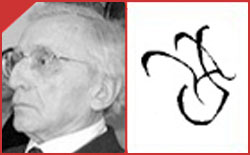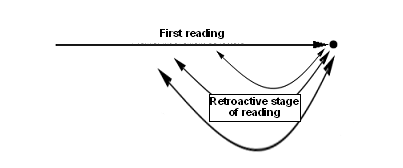Available Languages
- Consultez cette page en FRANÇAIS
- Consult this page in ENGLISH
Literariness and Signifiance
By Johanne Prud’homme and Nelson Guilbert
Université du Québec à Trois-Rivières
1. ABSTRACT
Riffaterre

According to Michael Riffaterre, the process of communication that unfolds between a text and its reader is not the same as that involved in so-called normal communication. The reader's encounter with the literary text is an experience of something unique, for which the main corollary is its style. The style becomes evident to the reader through the presence in the text of ungrammaticalities, those incongruous elements that disrupt the textual grammar. The phrase "a river on her way to work" in the following verse is an ungrammaticality: "It's okay to be run over by a river / on her way to work" (Willis, 1996, 233).
This text may be reproduced for non-commercial purposes, provided the complete reference is given:
Johanne Prud’homme and Nelson Guilbert (2006), « Literariness and Signifiance », in Louis Hébert (dir.), Signo [online], Rimouski (Quebec), http://www.signosemio.com/riffaterre/literariness-and-signifiance.asp.
2. THEORY
According to Michael Riffaterre, the reader's encounter with a text is not comparable to the process governing so-called normal communication. This unique experience (literary communication) is mediated in some way by the style of the work, which is manifested by means of ungrammaticalities.
2.1 LITERARY COMMUNICATION
In an everyday communication setting, as Jakobson's famous model reveals, the two-way relationship develops primarily between the encoder and the decoder, or sender and receiver, or addresser and addressee, if you prefer: The first sends a message using a code, which refers to a referent in a given context. The decoder receives the data and interprets them in order to understand the message.
However, when we read a book, the encoder is not present, and so the relationship is transformed; it becomes a direct relationship between the decoder and the message itself: the book. With no direct access to the encoder, the referents, or any reality outside the book, the reader can only deduce these elements, which is why Riffaterre claims that "reality and the author are substitutes for the text" (Riffaterre, 1983, 4). And since the reader has nothing before him but the text, it is the text that should demand his attention. The following diagram, based on Jakobson's communication model, illustrates the unusual relationships between the various elements involved in literary communication.
Literary communication

The very nature of this communication process ensures that the function of language is transformed from mimesis to semiosis. That is, literary language –and poetic language even more so – endeavours not to represent reality, but to establish a unified, coherent system of signification.
2.2 LITERARINESS AND THE LITERARY TEXT
According to Michael Riffaterre, the uniqueness of each literary text is indisputable: "The text is always one of a kind, unique. And it seems to me that this uniqueness is the simplest definition of literariness that we can find" (Riffaterre, 1983, 2).
What the hermeneutics call "style" is defined here as the main corollary of literariness. But unlike the hermeneutics, Riffaterre's concept of style does not refer back to the author. "The text works like a computer program designed to make us experience the unique. This uniqueness is what we call style. It has long been confused with the hypothetical individual termed the author; but, in point of fact, style is the text itself" (Riffaterre, 1983, 2). His position can thus be expressed by a series of equivalences that might read as follows:
Text = Uniqueness = Style = Literariness.
2.3 SIGNIFICANCE
"From the standpoint of meaning the text is a string of successive information units. From the standpoint of significance the text is one semantic unit." (Riffaterre, 1978, 3)
When reading a literary work, the reader must constantly be aware of the multiplicity of representations that the text imposes on him. They are disseminated throughout the work as constituents of a matrix not expressly announced by the text, and they generate effects that are perceivable. The reader must keep on "pushing the meaning over to a text not present in the linearity" (Riffaterre, 1978, 12). This operation, constantly reiterated, is what creates significance, which may be defined as "the reader's praxis of the transformation" (Riffaterre, 1978, 12). From this standpoint, reading is more than a simple one-way operation of identifying signs put down on paper. According to Riffaterre, the text makes it apparent that "[it] is constructed in such a way that it can control its own decoding" (Riffaterre, 1983, 6) and consequently, it acts on the reader as much as the reader acts on it. But how is the text organized, and how does it make its mechanisms and significance apparent to the reader? The key to this puzzle is found in the concept of stylistic units.
Riffaterre defines the stylistic unit as "a dyad made up of inseparable poles, the first of which creates a probability and the second of which frustrates that probability. The contrast between the two results in a stylistic effect" (Riffaterre, 1983, 7). The first of the two poles – the one that creates the probability – is the grammar established by the text, that is, a series of expected, mimetic utterances that appear normal at first glance.
NOTE ON GRAMMAR
Grammar is a semantic system established by mimesis, and is generally built on a set of descriptive systems and clichés. It is the rule that the reader expects, making the text understandable and coherent. Ungrammaticality is what breaks this rule and thereby distorts mimesis.
In a literary text, the reader will encounter ungrammaticalities: the apparently incongruous elements that come in and disrupt the grammar of the text. This is where we find the second pole of the dyad: the stylistic unit. Ungrammaticality is an element that modifies the grammar of the text, and in such a way that it no longer accurately represents reality. Ungrammaticality is what allows us to jump from mimesis to semiosis and thereby gain access to the significance of the text.
When we apply Riffaterre's theories, moreover, we must always consider stylistic units in their entirety and avoid analyzing words in isolation, for words should always be studied in the context of their relationships within a stylistic whole: Grammar and ungrammaticality are interdependent when it comes to creating meaning.
2.4 UNGRAMMATICALITY AND PERCEPTIBILITY
The primary feature of ungrammaticality is undoubtedly its ambiguity: The reader, confronted with an obvious distortion of mimesis, has the impression that since the text now refers to nothing, it loses its meaning temporarily. The reader then tries to superimpose his own interpretation on the text, an interpretation that will change as he progresses, as we will see.
Ambiguity and obscurity in a text should be treated as ambiguity and obscurity, and not explained away, since confusion and polysemy are encoded in the text: "[...] all words are polysemous. For polysemy to have a role in style, the plural reading must impose itself on the reader" (Riffaterre, 1983, 10).
Moreover, one of the characteristics of ungrammaticality is that it must be perceptible; if it harbours a hidden meaning, the text will give formal indices to the reader, who will furnish the key to interpretation. These indices exhibit two features, or properties:
- A deictic feature, perceived as a distortion of mimesis, "encoded in such a way that, first, it reveals that it is hiding something" (Riffaterre, 1983, 12).
- A hermeneutic feature: the sort of distortion of mimesis that "indicates how we can find that something" (Riffaterre, 1983, 12).
The following diagram illustrates how, by recognizing the indices of ungrammaticality, the reader is forced to hurdle the linearity of mimesis. Grasping the relationships between the elements that are distributed along the axis of mimesis is part of the praxis of transformation that creates significance, and this is made possible by instances of ungrammaticality.
Genesis of significance

To gain access to significance, we must be aware of the various ungrammaticalities encountered in the text, and attempt to discern some structure that they have in common. This is accomplished with a dynamic gesture known as retroactive reading: "As he progresses through the text, the reader remembers what he has just read and modifies his understanding of it in the light of what he is now decoding" (Riffaterre, 1978, 5).
Retroactive reading

By identifying the various stylistic units and finding their common structure, the reader manages to decipher the text's mechanisms and grasp its significance. Through this effort of decoding the structures, the reader accomplishes what is called a hermeneutic reading. For the text is "a variation or modulation of one structure [...] and this sustained relation to one structure constitutes the significance" (Riffaterre, 1978, 6).
3. APPLICATION
Ungrammaticality and the stylistic unit are at the core of Michael Riffaterre's theory. Here we will illustrate.
According to Riffaterre, the ungrammaticalities are what lead the reader to an interpretation, to a second-stage reading. For example, in Paul Éluard's famous verse, "la terre est bleue comme une orange" ["the Earth is blue like an orange"], the meaning of a set expression (la terre est bleue) has its probability altered in this context due to the ungrammaticality that is actualized in the phrase comme une orange. The presence of this ungrammaticality is what creates the stylistic unit.
Stylistic unit

4. LIST OF WORKS CITED
- WILLIS, P., "Meeting Like This", in Rich, Adrienne, The Best American Poetry, New York: Scribner, 1996.
- RIFFATERRE, M., Text Production, New York: Columbia University Press, 1983.
- RIFFATERRE, M., Semiotics of Poetry, Bloomington: Indiana University Press, 1978.
5. EXERCISE
L’albatros
Souvent, pour s'amuser, les hommes d'équipage
Prennent des albatros, vastes oiseaux des mers,
Qui suivent, indolents compagnons de voyage,
Le navire glissant sur les gouffres amers.
À peine les ont-ils déposés sur les planches,
Que ces rois de l'azur, maladroits et honteux,
Laissent piteusement leurs grandes ailes blanches
Comme des avirons traîner à côté d'eux.
Ce voyageur ailé, comme il est gauche et veule!
Lui, naguère si beau, qu'il est comique et laid!
L'un agace son bec avec un brûle-gueule,
L'autre mime, en boitant, l'infirme qui volait!
Le Poète est semblable au prince des nuées
Qui hante la tempête et se rit de l'archer;
Exilé sur le sol au milieu des huées,
Ses ailes de géant l'empêchent de marcher.
The Albatross
Often, for pastime, mariners will ensnare
The albatross, that vast seabird who sweeps
On high companionable pinion where
Their vessel glides upon the bitter deeps.
Torn from his native space, this captive king
Flounders upon the deck in stricken pride,
And pitiably lets his great white wing
Drag like a heavy paddle at his side.
This rider of winds, how awkward he is, and weak!
How droll he seems, who lately was all grace!
A sailor pokes a pipestem into his beak;
Another, hobbling, mocks his trammeled pace.
The Poet is like this monarch of the clouds,
Familiar of storms, or stars, and of all high things;
Exiled on earth amidst its hooting crowds,
He cannot walk, borne down by his giant wings.

